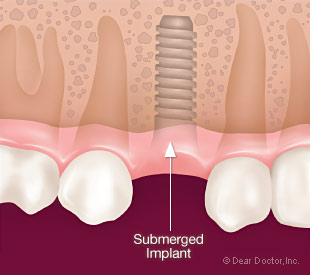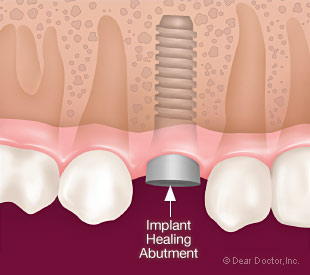Staging Surgery In Implant Dentistry
One or two stage implant surgery options
Dear Doctor,
I have read lately that implants can be done in two ways — either in one or two stages. Could you explain what this means as well as the pros and cons of each method?
 |
| An example of a dental implant placed into the bone and covered by the gum tissue. This will require a second surgery to uncover the implant (two stage implant surgery). |
 |
| An example of a dental implant placed into the bone with a healing abutment attached protruding through the gum tissue (one stage implant surgery). |
Dear Diane,
This is a good question with a rather interesting answer. First a few basics — a dental implant is used to replace a tooth root that eventually becomes anchored in the bone. This essential step for making implants successful is called osseo-integration (“osseo” – bone; “integration” – fusion or joining with).
Placement of dental implants is a surgical procedure requiring precision shaping of the bone to create an osteotomy (“osteo” – bony; “otomy” – reshaping). That's a very fancy word for the creation of a receptacle or plainly speaking a “hole” or “channel.” Precision is essential so that the bone is protected and cooled during preparation taking care to keep it viable and alive. Implants must be placed in intimate contact with the bone to facilitate the integration process. When carefully treated, the cells will adhere to the implant surfaces, which are usually made of commercially pure and specially treated titanium — that's the magic!
Dr. Per-Ingvar Brånemark, the researcher who discovered the osseo-integration process, developed a protocol in which the newly placed implants were left submerged beneath the gum tissues, protected from the bacteria in the environment of the mouth, and free from the trauma of the bite. After a period of six months, a second small surgical procedure was performed (step or stage two), to re-expose the implant into the mouth. A healing abutment was temporarily used until the permanent crown could be fabricated. Then, by means of a special attachment called a permanent abutment, a crown (the tooth part you see above the gum) was then attached to it. This was the genesis of the two-stage procedure.
Since that time other implant “systems” have been developed that provide for placement of the implants in the bone, leaving them protruding through the gum tissue, essentially constituting a “one stage” system, and eliminating the second stage healing time generally requiring a further 6-8 weeks.
What does this mean in actuality?
Most experienced surgical dental specialists who place implants will probably agree that either choice can be successful in the right circumstances. Whether to use a one or two-stage system or approach today depends on which tooth has been lost (a front tooth which will need a cosmetic solution versus a back tooth which does not require replacement for the short term) as well as the quality of the bone (back teeth are subject to more biting force than front teeth). Not all bone is the same; some is very hard in which case it is relatively easy to stabilize an implant at the time of surgical placement.
Achieving primary stability at the time of surgical implant placement is a good predictor of healing and proper integration with the bone, and is more difficult to obtain where the bone is softer such as in the back areas of the mouth. Think of the difference between oak and balsa wood. Any early movement of the implant, even microscopic, can deter this delicate process in the first month.
However, there are variations of the one stage approach. On occasion, it is possible to immediately place a temporary crown on an implant so that a person can leave their dentist's office with a tooth. This “one stage” application can sometimes be accomplished after the extraction site has healed or immediately after tooth removal. When a tooth is removed and an implant is placed at the same time, this is referred to as immediate implant placement. Additionally, an immediate crown is fabricated and simultaneously placed by a restorative dentist. Primary stability in this special situation is critical, requiring great surgical precision, care and experience. Great care must also be taken to ensure that the crown is out of biting contact with its opposing tooth — and no biting on hard or chewy foods is permitted during the healing or integration phase.
For situations in which people with systemic (general body) disease like diabetes, or smokers, in which healing may be compromised, the balance might be tipped toward choosing a two stage implant system in which it may be advantageous to allow “submerged” healing to occur to avoid any outside influences (plaque or biting forces) from compromising healing.
In either case, whether a one or two stage implant system is used, either can result in great long-term success. Other factors that may enter the mix are the particular implant type, the system (there are multiple on the market — each with different characteristics), and most important, clinical experience and know how. That gets one back to the reality that dentistry is often as much art as it is science.



